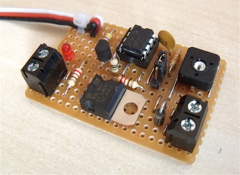
|
|
|
|
PICAXE RC SWITCH
Unlike RC switches utilising relays, the switch "contacts" are not floating to be assigned as you wish - the 'hot side' of the load *must* be wired to the +ve of its power source - and the 'cold' side of the load is switched to 0v by the MOSFET. This is taken care of in the stripboard layout if connected as shown. The design is easily adapted to utilise a relay if preferred. A transistor buffer is used to condition the signal from the receiver. The output voltage swing of some receivers (especially 2.4Ghz types) has been found to be insufficient to trigger the PICAXE 08M (Schmitt Trigger type) input. An LED is also connected to the gate of the MOSFET to indicate the on/off state of the switch. A 'catch' diode protects the MOSFET from high flyback voltage spikes caused by switching inductive loads (like motors). As can be seen from the picture, the unit is easily constructed on stripboard and those of you wishing to build one for yourselves should follow the link http://www.technobotsonline.com/rc-switch.html where you will find additional technical detail, a stripboard layout diagram and parts list (all parts are available from Technobots). |

